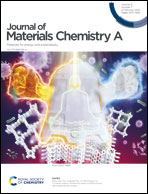Over 8% efficient CsSnI3-based mesoporous perovskite solar cells enabled by two-step thermal annealing and surface cationic coordination dual treatment†
Abstract
All-inorganic tin halide perovskite compounds, such as CsSnI3, have attracted attention in the field of solar cells due to their eco-friendly properties. It is quite a challenge to fabricate high-quality CsSnI3 perovskite films with low defect density due to the low defect tolerance and overquick crystallization growth rate. Herein, we propose a simple yet effective method to modulate the dynamic balance between the growth and nucleation of perovskite crystals for black orthorhombic phase CsSnI3. We found that well-crystallized CsSnI3 thin films can be easily obtained through two-step thermal annealing at low temperatures of 40 °C and 70 °C. We further introduced 1-(4-carboxyphenyl)-2-thiourea to coordinate with surface undercoordinated Sn2+ cations of CsSnI3 thin films through C![[double bond, length as m-dash]](https://www.rsc.org/images/entities/char_e001.gif) S and C
S and C![[double bond, length as m-dash]](https://www.rsc.org/images/entities/char_e001.gif) O functional groups, significantly decreasing the defect density. The CsSnI3 perovskite solar cells based on a printable c-TiO2/m-TiO2/Al2O3/NiO/carbon mesoporous framework achieved a power conversion efficiency of 8.03% with high reproducibility, which is the best efficiency among those reported for all-inorganic CsSnI3 mesoporous perovskite solar cells to date. Furthermore, the corresponding devices retained 90% of the initial efficiency after 3000 hours of storage in a N2-filled glovebox.
O functional groups, significantly decreasing the defect density. The CsSnI3 perovskite solar cells based on a printable c-TiO2/m-TiO2/Al2O3/NiO/carbon mesoporous framework achieved a power conversion efficiency of 8.03% with high reproducibility, which is the best efficiency among those reported for all-inorganic CsSnI3 mesoporous perovskite solar cells to date. Furthermore, the corresponding devices retained 90% of the initial efficiency after 3000 hours of storage in a N2-filled glovebox.



 Please wait while we load your content...
Please wait while we load your content...